Forest Phenology under Differing Topographic Conditions: A Case Study of Changbai Mountain in Northeast China
Abstract
1. Introduction
2. Data and Methods
2.1. Study Area
2.2. Field Survey
2.3. Remote Sensing Data and DEM Data Processing
2.4. Data Fusion, Phenology Extraction, and Analysis Methods
2.4.1. Data Fusion Method
2.4.2. Methods for Extracting Phenology Information
2.4.3. Correlation Analysis and Trend Analysis Methods
3. Results
3.1. Temporal and Spatial Patterns of Forest Phenology in the Recent 10 Years
3.2. Forest Type Distribution Pattern and the Phenology Characteristics of Different Forest Types
3.3. Topographic Differentiation of Forest Phenology
3.3.1. Differentiation of Forest Phenology with Altitude
3.3.2. Change Characteristics of Forest Phenology with Slope Gradient
3.3.3. Change Characteristics of Forest Phenology with Various Aspects
4. Discussion
4.1. The Response Characteristics of Temperate Forests to Climate Change
4.2. Effects of Elevation and Topography on Forest Phenology
4.3. Limitations and Prospects
5. Conclusions
Author Contributions
Funding
Data Availability Statement
Conflicts of Interest
References
- Bonan, G.B. Forests and climate change: Forcings, feedbacks, and the climate benefits of forests. Science 2008, 320, 1444–1449. [Google Scholar] [CrossRef] [PubMed]
- Chen, C.; Park, T.; Wang, X.H.; Piao, S.L.; Xu, B.D.; Chaturvedi, R.K.; Fuchs, R.; Brovkin, V.; Ciais, P.; Fensholt, R.; et al. China and India lead in greening of the world through land-use management. Nat. Sustain. 2019, 2, 122–129. [Google Scholar] [CrossRef] [PubMed]
- Song, W.Q.; Feng, Y.H.; Wang, Z.H. Ecological restoration programs dominate vegetation greening in China. Sci. Total Environ. 2022, 848, 157729. [Google Scholar] [CrossRef] [PubMed]
- Richardson, A.D.; Keenan, T.F.; Migliavacca, M.; Ryu, Y.; Sonnentag, O.; Toomey, M. Climate change, phenology, and phenological control of vegetation feedbacks to the climate system. Agric. For. Meteorol. 2013, 169, 156–173. [Google Scholar] [CrossRef]
- Aono, Y.; Kazui, K. Phenological data series of cherry tree flowering in Kyoto, Japan, and its application to reconstruction of springtime temperatures since the 9th century. Int. J. Climatol. 2008, 28, 905–914. [Google Scholar] [CrossRef]
- Zhang, X.Y.; Friedl, M.A.; Schaaf, C.B.; Strahler, A.H.; Hodges, J.C.F.; Gao, F.; Reed, B.C.; Huete, A. Monitoring vegetation phenology using MODIS. Remote Sens. Environ. 2003, 84, 471–475. [Google Scholar] [CrossRef]
- Piao, S.L.; Fang, J.Y.; Zhou, L.M.; Ciais, P.; Zhu, B. Variations in satellite-derived phenology in China’s temperate vegetation. Glob. Change Biol. 2006, 12, 672–685. [Google Scholar] [CrossRef]
- Shen, M.G.; Piao, S.L.; Dorji, T.; Liu, Q.; Cong, N.; Chen, X.Q.; An, S.; Wang, S.P.; Wang, T.; Zhang, G.X. Plant phenological responses to climate change on the Tibetan Plateau: Research status and challenges. Natl. Sci. Rev. 2015, 2, 454–467. [Google Scholar] [CrossRef]
- Ciais, P.; Reichstein, M.; Viovy, N.; Granier, A.; Ogée, J.; Allard, V.; Aubinet, M.; Buchmann, N.; Bernhofer, C.; Carrara, A.; et al. Europe-wide reduction in primary productivity caused by the heat and drought in 2003. Nature 2005, 437, 529–533. [Google Scholar] [CrossRef]
- Zhu, Z.C.; Piao, S.L.; Myneni, R.B.; Huang, M.T.; Zeng, Z.Z.; Canadell, J.G.; Ciais, P.; Sitch, S.; Friedlingstein, P.; Arneth, A.; et al. Greening of the Earth and its drivers. Nat. Clim. Change 2016, 6, 791–795. [Google Scholar] [CrossRef]
- Fang, Z.X.; Brandt, M.; Wang, L.H.; Fensholt, R. A global increase in tree cover extends the growing season length as observed from satellite records. Sci. Total Environ. 2022, 806, 151205. [Google Scholar] [CrossRef]
- Liu, Q.; Fu, Y.H.; Zhu, Z.C.; Liu, Y.W.; Liu, Z.; Huang, M.T.; Janssens, I.A.; Piao, S.L. Delayed autumn phenology in the Northern Hemisphere is related to change in both climate and spring phenology. Glob. Change Biol. 2016, 22, 3702–3711. [Google Scholar] [CrossRef]
- Huang, Z.; Zhou, L.; Chi, Y.G. Spring phenology rather than climate dominates the trends in peak of growing season in the Northern Hemisphere. Glob. Change Biol. 2023, 29, 4543. [Google Scholar] [CrossRef]
- Zheng, W.R.; Liu, Y.Q.; Yang, X.G.; Fan, W.Y. Spatiotemporal Variations of Forest Vegetation Phenology and Its Response to Climate Change in Northeast China. Remote Sens. 2022, 14, 2909. [Google Scholar] [CrossRef]
- Qader, S.H.; Priyatikanto, R.; Khwarahm, N.R.; Tatem, A.; Dash, J.A.J. Characterising the Land Surface Phenology of Middle Eastern Countries Using Moderate Resolution Landsat Data. Remote Sens. 2022, 14, 2136. [Google Scholar] [CrossRef]
- Yang, J.W.; Zhang, Q.L.; Song, W.Q.; An, Y.; Wang, X.C. Divergent response of Pinus pumila growth to climate warming at different latitudes and in different simulation predictions. Front. For. Glob. Change 2022, 5, 1075100. [Google Scholar] [CrossRef]
- Taylor, G.; Tallis, M.J.; Giardina, C.P.; Percy, K.E.; Miglietta, F.; Gupta, P.S.; Gioli, B.; Calfapietra, C.; Gielen, B.; Kubiske, W.E.; et al. Future atmospheric CO2 leads to delayed autumnal senescence. Glob. Change Biol. 2008, 14, 264–275. [Google Scholar] [CrossRef]
- Maignan, F.; Bréon, F.M.; Bacour, C.; Demarty, J.; Poirson, A. Interannual vegetation phenology estimates from global AVHRR measurements. Remote Sens. Environ. 2008, 112, 496–505. [Google Scholar] [CrossRef]
- Chen, L.; Huang, J.G.; Ma, Q.; Hänninen, H.; Rossi, S.; Piao, S.L.; Bergeron, Y. Spring phenology at different altitudes is becoming more uniform under global warming in Europe. Glob. Change Biol. 2018, 24, 3969–3975. [Google Scholar] [CrossRef]
- Asse, D.; Chuine, I.; Vitasse, Y.; Yoccoz, N.G.; Delpierre, N.; Badeau, V.; Delestrade, A.; Randin, C.F. Warmer winters reduce the advance of tree spring phenology induced by warmer springs in the Alps. Agric. For. Meteorol. 2018, 252, 220–230. [Google Scholar] [CrossRef]
- Gao, M.D.; Piao, S.L.; Chen, A.P.; Yang, H.; Liu, Q.; Fu, Y.H.; Janssens, I.A. Divergent changes in the elevational gradient of vegetation activities over the last 30 years. Nat. Commun. 2019, 10, 2970. [Google Scholar] [CrossRef] [PubMed]
- Vitasse, Y.; Signarbieux, C.; Fu, Y.H. Global warming leads to more uniform spring phenology across elevations. Proc. Natl. Acad. Sci. USA 2018, 115, 1004–1008. [Google Scholar] [CrossRef] [PubMed]
- Menzel, A.; Sparks, T.H.; Estrella, N.; Roy, D.B. Altered Geographic and Temporal Variability in Phenology in Response to Climate Change. Glob. Ecol. Biogeogr. 2006, 15, 498–504. [Google Scholar] [CrossRef]
- Wang, X.Y.; Zhou, Y.K.; Wen, R.H.; Zhou, C.H.; Xu, L.L.; Xi, X. Mapping Spatiotemporal Changes in Vegetation Growth Peak and the Response to Climate and Spring Phenology over Northeast China. Remote Sens. 2020, 12, 3977. [Google Scholar] [CrossRef]
- Cai, H.; Zhang, S.; Yang, X. Forest dynamics and their phenological response to climate warming in the Khingan Mountains, northeastern China. Int. J. Environ. Res. Public Health 2012, 9, 3943–3953. [Google Scholar] [CrossRef] [PubMed]
- Guo, J.T.; Hu, Y.M. Spatiotemporal Variations in Satellite-Derived Vegetation Phenological Parameters in Northeast China. Remote Sens. 2022, 14, 705. [Google Scholar] [CrossRef]
- Li, K.W.; Wang, C.Y.; Sun, Q.; Rong, G.Z.; Tong, Z.J.; Liu, X.P.; Zhang, J.Q. Spring Phenological Sensitivity to Climate Change in the Northern Hemisphere: Comprehensive Evaluation and Driving Force Analysis. Remote Sens. 2021, 13, 1972. [Google Scholar] [CrossRef]
- Hao, B.F.; Han, X.J.; Ma, M.G.; Liu, Y.T.; Li, S.W. Research progress on the application of Google Earth Engine in geoscience and environmental sciences. Remote Sens. Technol. Appl. 2018, 33, 600–611. [Google Scholar]
- Wang, C.; Fang, C.F.; Zhao, S.D.; Dong, S.L. Plantae Novae Salicum Sinicarum(Ⅰ). Bull. Bot. Res. 1980, 4, 1–21. [Google Scholar]
- Zhao, S.Q.; Fang, J.Y.; Zong, Z.J.; Zhu, B. Composition, structure and species diversity of plant communities along an altitudinal gradient on the northern slope of Mt. Changbai, Northeast China. Biodivers. Sci. 2004, 12, 164–173. [Google Scholar] [CrossRef]
- Xu, Z.Z.; Liu, Q.J.; Du, W.X.; Zhou, G.; Qin, L.H.; Sun, Z. Modelling leaf phenology of some trees with accumulated temperature in a temperate forest in northeast China. For. Ecol. Manag. 2021, 489, 119085. [Google Scholar] [CrossRef]
- Tang, G.A.; Na, J.M.; Cheng, W.M. Progress of digital terrain analysis on regional geomorphology in China. Acta Geod. Cartogr. Sin. 2017, 46, 1570–1591. [Google Scholar]
- Hou, J.W.; Van, D.A.I.J.M.; Renzullo, L.J. Merging Landsat and airborne LiDAR observations for continuous monitoring of floodplain water extent, depth and volume. J. Hydrol. 2022, 609, 127684. [Google Scholar] [CrossRef]
- Cao, R.Y.; Chen, Y.; Chen, J.; Zhu, X.L.; Shen, M.G. Thick cloud removal in Landsat images based on autoregression of Landsat time-series data. Remote Sens. Environ. 2020, 249, 112001. [Google Scholar] [CrossRef]
- Zhu, Z.; Woodcock, C.E. Object-based cloud and cloud shadow detection in Landsat imagery. Remote Sens. Environ. 2012, 118, 83–94. [Google Scholar] [CrossRef]
- Wulder, M.A.; Roy, D.P.; Radeloff, V.C.; Loveland, T.R.; Anderson, M.C.; Johnson, D.M.; Healey, S.; Zhu, Z.; Scambos, T.A.; Pahlevan, N.; et al. Fifty years of Landsat science and impacts. Remote Sens. Environ. 2022, 280, 113195. [Google Scholar] [CrossRef]
- Skakun, S.; Wevers, J.; Brockmann, C.; Doxani, G.; Aleksandrov, M.; Batič, M.; Frantz, D.; Gascon, F.; Gómez-Chova, L.; Hagolle, O.; et al. Cloud Mask Intercomparison eXercise (CMIX): An evaluation of cloud masking algorithms for Landsat 8 and Sentinel-2. Remote Sens. Environ. 2022, 274, 112990. [Google Scholar] [CrossRef]
- Chen, Y.; Cao, R.Y.; Chen, J.; Liu, L.C.; Matsushita, B. A practical approach to reconstruct high-quality Landsat NDVI time-series data by gap filling and the Savitzky–Golay filter. ISPRS J. Photogramm. Remote Sens. 2021, 180, 174–190. [Google Scholar] [CrossRef]
- Zhang, X.; Liu, L.Y.; Chen, X.D.; Gao, Y.; Xie, S.; Mi, J. GLC_FCS30: Global land-cover product with fine classification system at 30 m using time-series Landsat imagery. Earth Syst. Sci. Data 2021, 13, 2753–2776. [Google Scholar] [CrossRef]
- Chen, F.; Yuan, Y.J.; Wei, W.S.; Fan, Z.A.; Zhang, T.W.; Shang, H.M.; Zhang, R.B.; Yu, S.L.; Ji, C.R.; Qin, L. Climatic response of ring width and maximum latewood density of Larix sibirica in the Altay Mountains, reveals recent warming trends. Ann. Forest Sci. 2012, 69, 723–733. [Google Scholar] [CrossRef]
- Zhou, P.; Huang, J.G.; Liang, H.X.; Rossi, S.; Bergeron, Y.; Shishov, V.V.; Jiang, S.W.; Kang, J.; Zhu, H.X.; Dong, Z.C. Radial growth of Larix sibirica was more sensitive to climate at low than high altitudes in the Altai Mountains, China. Agric. For. Meteorol. 2021, 304, 108392. [Google Scholar] [CrossRef]
- Liu, B.H.; Xu, M.; Henderson, M.; Qi, Y.; Li, Y.Q. Taking China’s Temperature: Daily Range, Warming Trends, and Regional Variations, 1955–2000. Am. Meteorol. Soc. 2004, 17, 4453–4462. [Google Scholar] [CrossRef]
- Zhang, X.W.; Liu, X.H.; Zhang, Q.L.; Zeng, X.M.; Xu, G.B.; Wu, G.J.; Wang, W.Z. Species-specific tree growth and intrinsic water-use efficiency of Dahurian larch (Larix gmelinii) and Mongolian pine (Pinus sylvestris var. mongolica) growing in a boreal permafrost region of the Greater Hinggan Mountains, Northeastern China. Agric. For. Meteorol. 2018, 248, 145–155. [Google Scholar] [CrossRef]
- Tan, J.G.; Piao, S.L.; Chen, A.P.; Zeng, Z.Z.; Ciais, P.; Janssens, I.A.; Mao, J.F.; Myneni, R.B.; Peng, S.S.; Peñuelas, J.; et al. Seasonally different response of photosynthetic activity to daytime and night-time warming in the Northern Hemisphere. Glob. Change Biol. 2015, 21, 377–387. [Google Scholar] [CrossRef]
- Zhang, F.Y.; Liu, B.H.; Henderson, M.; Shen, X.J.; Su, Y.H.; Zhou, W.Y. Changing Spring Phenology of Northeast China Forests during Rapid Warming and Short-Term Slowdown Periods. Forests 2022, 13, 2173. [Google Scholar] [CrossRef]
- Vitasse, Y.; Delzon, S.; Dufrene, E.; Pontailler, J.Y.; Louvet, J.M.; Kremer, A.; Michalet, R. Leaf phenology sensitivity to temperature in European trees: Do within-species populations exhibit similar responses? Agric. For. Meteorol. 2009, 149, 735–744. [Google Scholar] [CrossRef]
- Jeong, S.J.; Medvigy, D.; Shevliakova, E.; Malyshev, S. Uncertainties in terrestrial carbon budgets related to spring phenology. J. Geophys. Res. Biogeosci. 2012, 117, 269. [Google Scholar] [CrossRef]
- Steffen, W.; Richardson, K.; Rockström, J.; Cornell, S.E.; Fetzer, I.; Bennett, E.M.; Biggs, R.; Carpenter, S.R.; Vries, W.; Wit, C.A.; et al. Planetary boundaries: Guiding human development on a changing planet. Science 2015, 347, 1259855. [Google Scholar] [CrossRef]
- Astrup, R.; Bernier, P.Y.; Genet, H.; Lutz, D.A.; Bright, R.M. A sensible climate solution for the boreal forest. Nat. Clim. Change 2018, 8, 11–12. [Google Scholar] [CrossRef]
- Jong, R.; Michael, E.S.; Furrer, R.; Bruin, S.; Verburg, P.H. Spatial relationship between climatologies and changes in global vegetation activity. Glob. Change Biol. 2013, 19, 1953–1964. [Google Scholar] [CrossRef]
- Nemani, R.R.; Keeling, C.D.; Hashimoto, H.; Jolly, W.M.; Piper, S.C.; Tucker, C.J.; Myneni, R.B.; Running, S.W. Climate-Driven Increases in Global Terrestrial Net Primary Production from 1982 to 1999. Science 2003, 300, 1560–1563. [Google Scholar] [CrossRef]
- Menzel, A.; Sparks, T.H.; Estrella, N.; Koch, E.; Assa, A.; Ahas, R.; Alm, K.; Bissolli, P.; Braslavska, O.; Briede, A.; et al. European phenological response to climate change matches the warming pattern. Glob. Change Biol. 2006, 12, 1969–1976. [Google Scholar] [CrossRef]
- Melaas, E.K.; Friedl, M.A.; Richardson, A.D. Multiscale modeling of spring phenology across Deciduous Forests in the Eastern United States. Glob. Change Biol. 2016, 22, 792–805. [Google Scholar] [CrossRef]
- Shen, M.G.; Zhang, G.X.; Cong, N.; Wang, S.P.; Kong, W.D.; Piao, S.L. Increasing altitudinal gradient of spring vegetation phenology during the last decade on the Qinghai–Tibetan Plateau. Agric. For. Meteorol. 2014, 189, 71–80. [Google Scholar] [CrossRef]
- Marchin, M.R.; Salk, C.F.; Hoffmann, W.A.; Dunn, R.R. Temperature alone does not explain phenological variation of diverse temperate plants under experimental warming. Glob. Change Biol. 2015, 21, 3138–3151. [Google Scholar] [CrossRef]
- Justine, C.S.; Yann, V.; Michael, M.; Sylvain, D.; Christof, B. Temperature rather than individual growing period length determines radial growth of sessile oak in the Pyrenees. Agric. For. Meteorol 2022, 317, 108885. [Google Scholar]
- Roberto, C.; Lorenzo, B.; Mirco, M.; Edoardo, C.; Michele, M.; Marta, G.; Micol, R.; Consolata, S.; Umberto, M.C. On the spatial and temporal variability of Larch phenological cycle in mountainous areas. Eur. J. Remote Sens. 2009, 41, 79–96. [Google Scholar]
- Dunn, A.H.; Beurs, K.M. Land surface phenology of North American mountain environments using moderate resolution imaging spectroradiometer data. Remote Sens. Environ. 2011, 115, 1220–1233. [Google Scholar] [CrossRef]
- Ding, M.J.; Zhang, Y.L.; Sun, X.M.; Liu, L.S.; Wang, Z.F.; Bai, W.Q. Spatiotemporal variation in alpine grassland phenology in the Qinghai-Tibetan Plateau from 1999 to 2009. Chin. Sci. Bull. 2013, 58, 396–405. [Google Scholar] [CrossRef]
- Tang, H.; Li, Z.W.; Zhu, Z.L.; Chen, B.R.; Zhang, B.H.; Xin, X.P. Variability and climate change trend in vegetation phenology of recent decades in the Greater Khingan Mountain area, Northeastern China. Remote Sens. 2015, 7, 11914–11932. [Google Scholar] [CrossRef]
- Roerink, G.J.; Menenti, M.; Verhoef, W. Reconstructing cloudfree NDVI composites using Fourier analysis of time series. Int. J. Remote Sens. 2000, 21, 1911–1917. [Google Scholar] [CrossRef]
- White, M.A.; Beurs, K.; Didan, K.; Inouye, D.; Richardson, A.D.; Jensen, O.; O’Keefe, J.; Zhang, G.; Nemani, R.; Leeuwen, W.V.; et al. Intercomparison, interpretation, and assessment of spring phenology in North America estimated from remote sensing for 1982–2006. Glob. Change Biol. 2009, 15, 2335–2359. [Google Scholar] [CrossRef]
- An, S.; Zhang, X.Y.; Chen, X.Q.; Yan, D.; Henebry, G.M. An Exploration of Terrain Effects on Land Surface Phenology across the Qinghai–Tibet Plateau Using Landsat ETM+ and OLI Data. Remote Sens. 2018, 10, 1069. [Google Scholar] [CrossRef]
- Fu, X.L.; Wang, J.L.; Wang, H.M.; Dai, X.Q.; Yang, F.T.; Zhao, M. Response of the fine root production, phenology, and turnover rate of six shrub species from a subtropical forest to a soil moisture gradient and shading. Plant Soil 2015, 399, 135–146. [Google Scholar] [CrossRef]
- Che, M.L.; Chen, B.Z.; Innes, J.L.; Wang, G.Y.; Dou, X.M.; Zhou, T.M.; Zhang, H.F.; Yan, J.W.; Xu, G.; Zhao, H.W. Spatial and temporal variations in the end date of the vegetation growing season throughout the Qinghai–Tibetan Plateau from 1982 to 2011. Agric. For. Meteorol. 2014, 189–190, 81–90. [Google Scholar] [CrossRef]
- Shen, M.G.; Piao, S.L.; Cong, N.; Zhang, G.X.; Jassens, I.A. Precipitation impacts on vegetation spring phenology on the Tibetan Plateau. Glob. Change Biol. 2015, 21, 3647–3656. [Google Scholar] [CrossRef]
- Dong, C.Y.; Qiao, R.R.; Chang, X.L. Effects of aspect on phenology of Larix gmelinii forest in Northeast China. Sci. Rep. 2022, 12, 22177. [Google Scholar] [CrossRef]
- Chen, W.N.; Wang, H.; Xiao, X.J.; Chen, F.J.; Zhang, Z.Y.; Qi, Z.M.; Huang, Z.X. Effects of slope aspect on growth and reproduction of Fritillaria unibracteata (Liliaceae). Acta Ecol. Sin. 2016, 36, 8174–8182. [Google Scholar]
- Zeng, H.Q.; Jia, G.S.; Epstein, H. Recent changes in phenology over the northern high latitudes detected from multi-satellite data. Environ. Res. Lett. 2011, 6, 045508. [Google Scholar] [CrossRef]
- Zhang, G.L.; Zhang, Y.J.; Dong, J.W.; Xiao, X.M. Green-up dates in the Tibetan Plateau have continuously advanced from 1982 to 2011. Proc. Natl. Acad. Sci. USA 2013, 110, 4309–4314. [Google Scholar] [CrossRef]
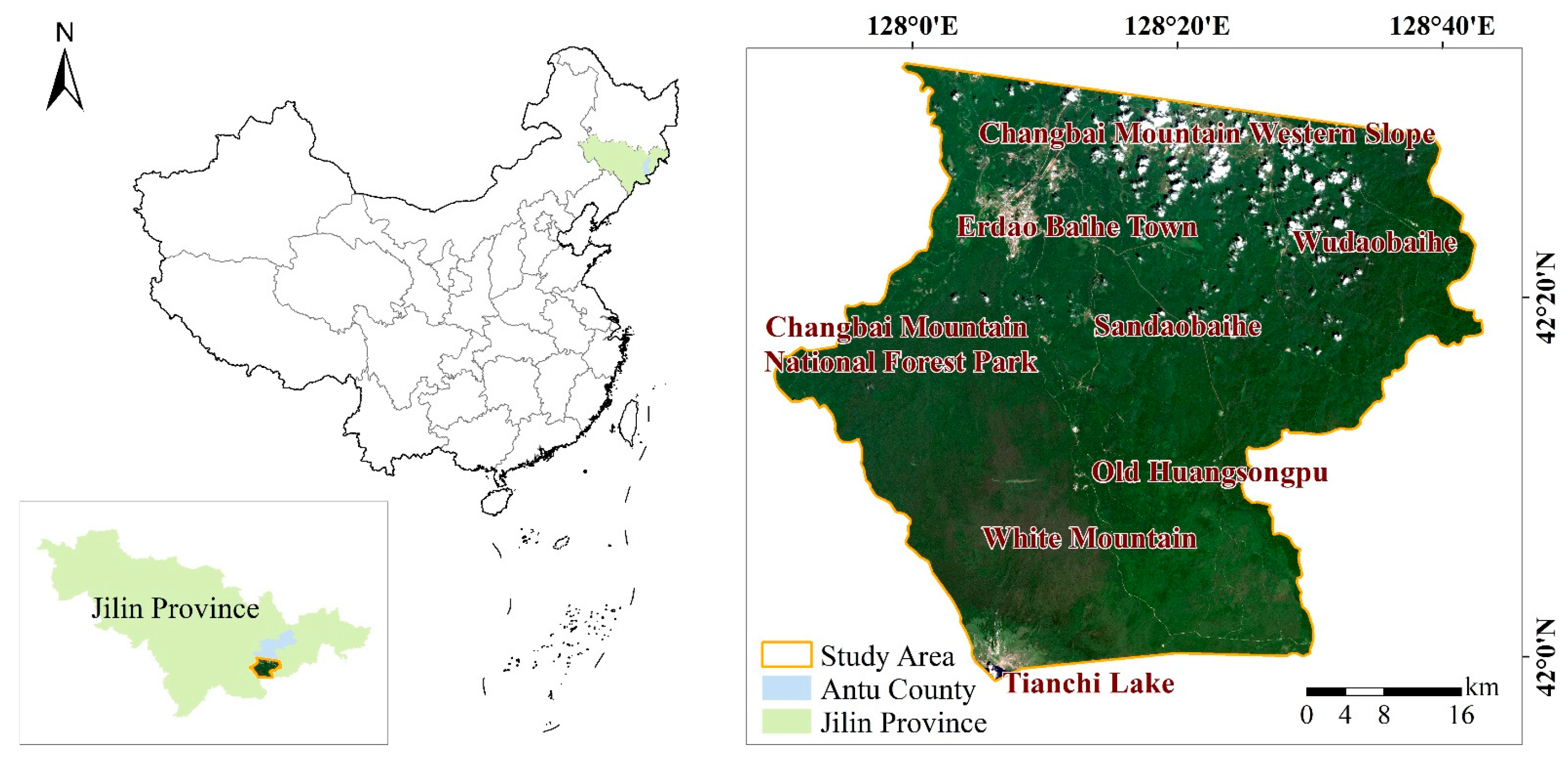
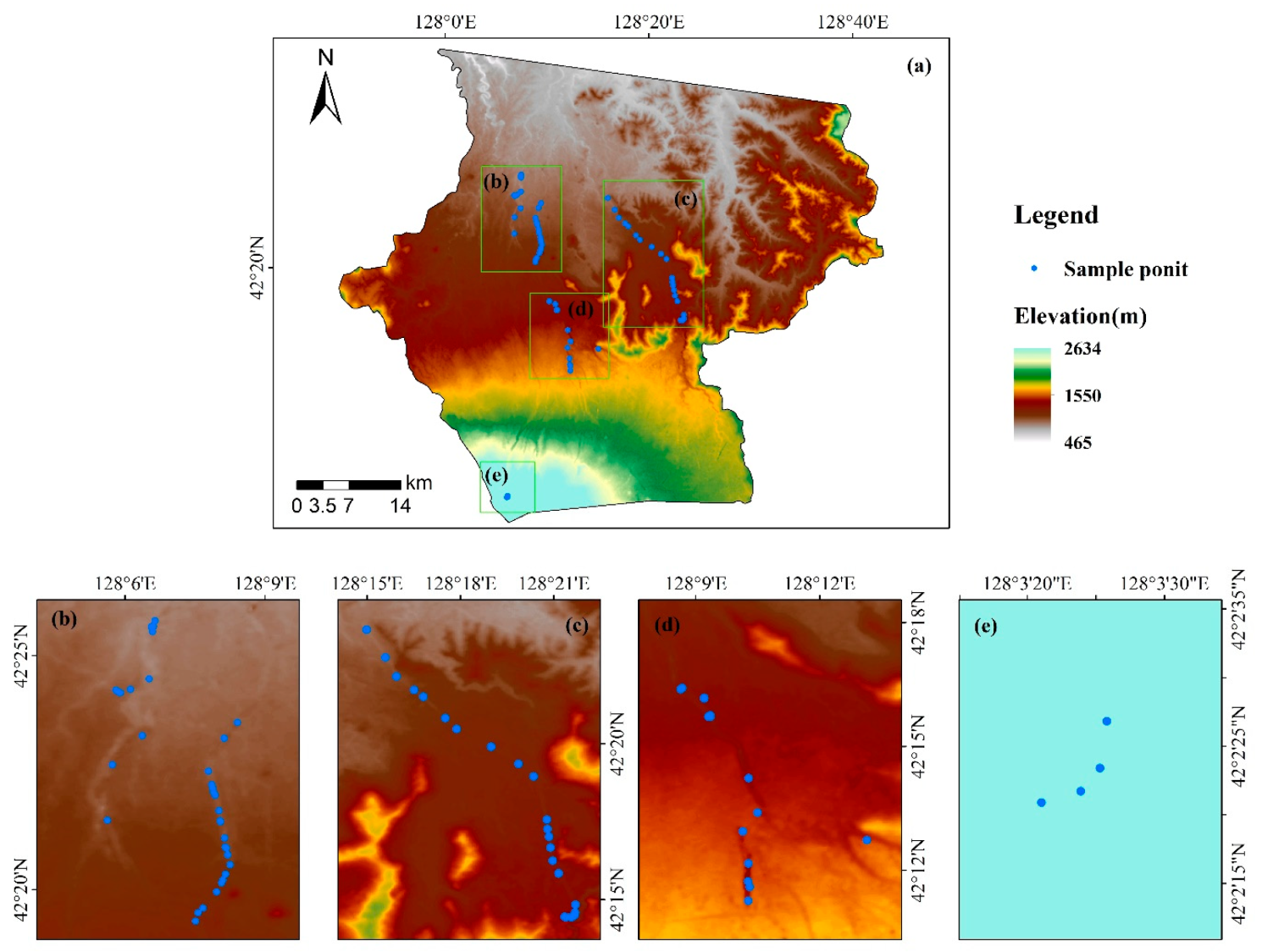

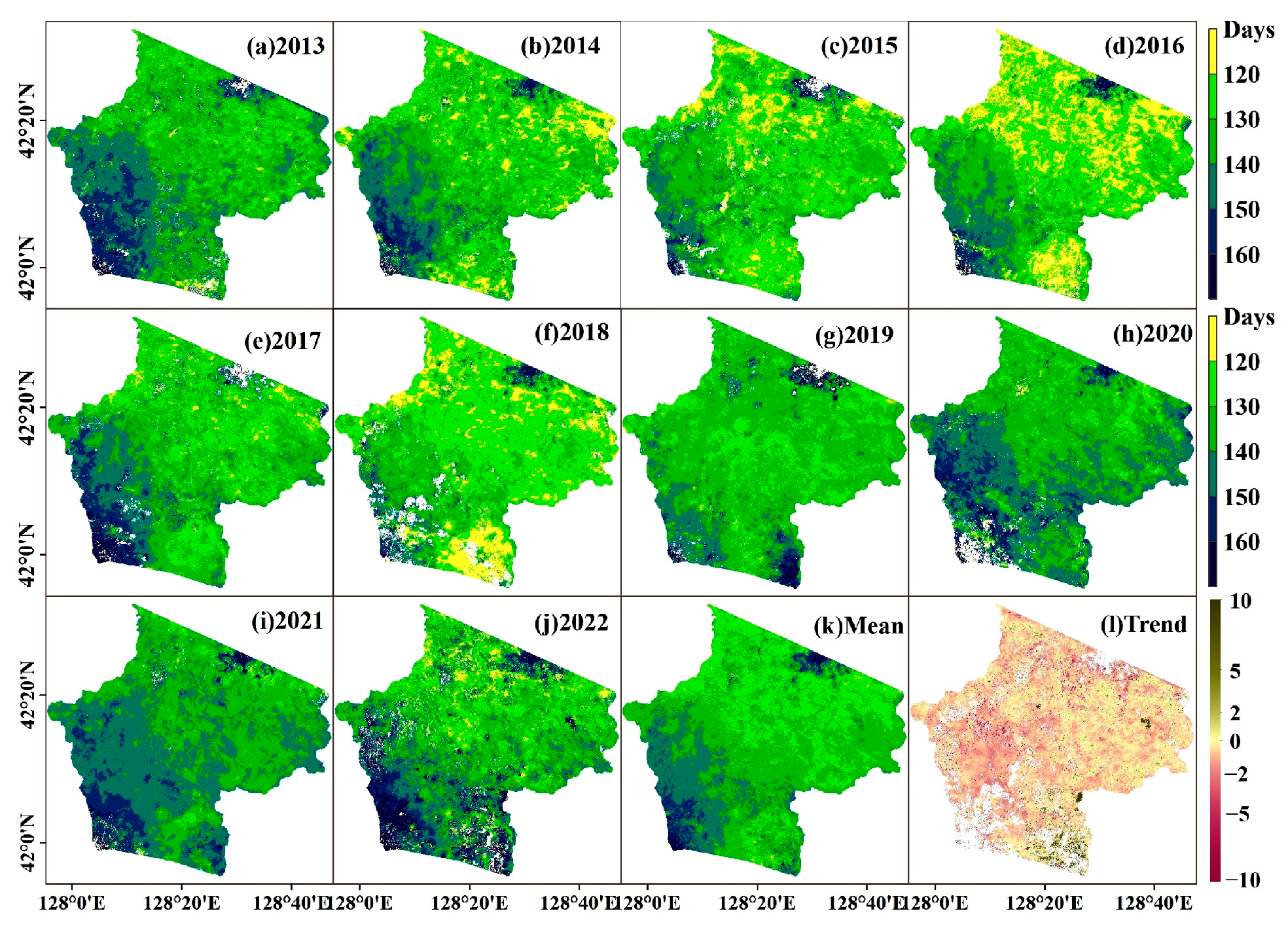
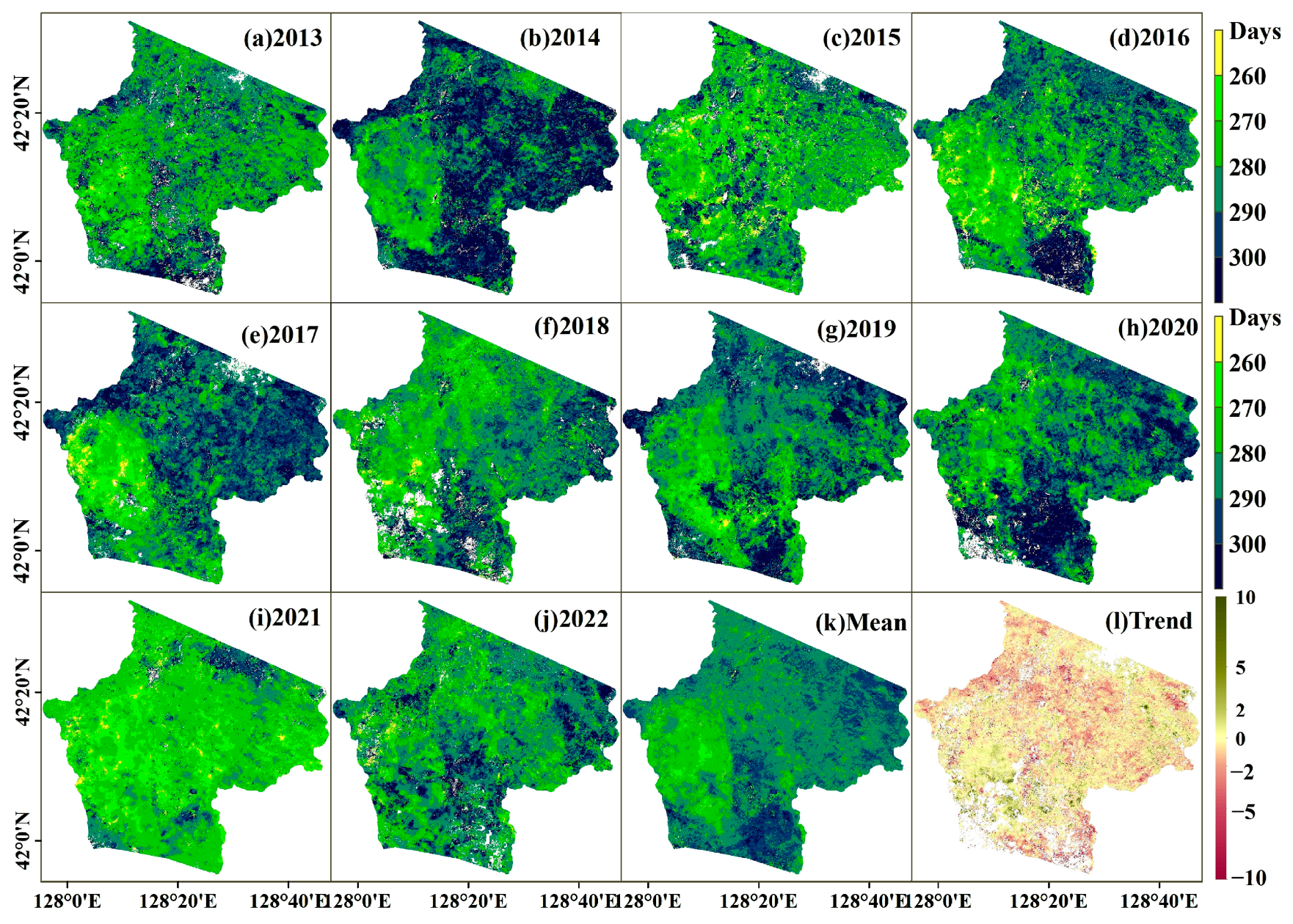


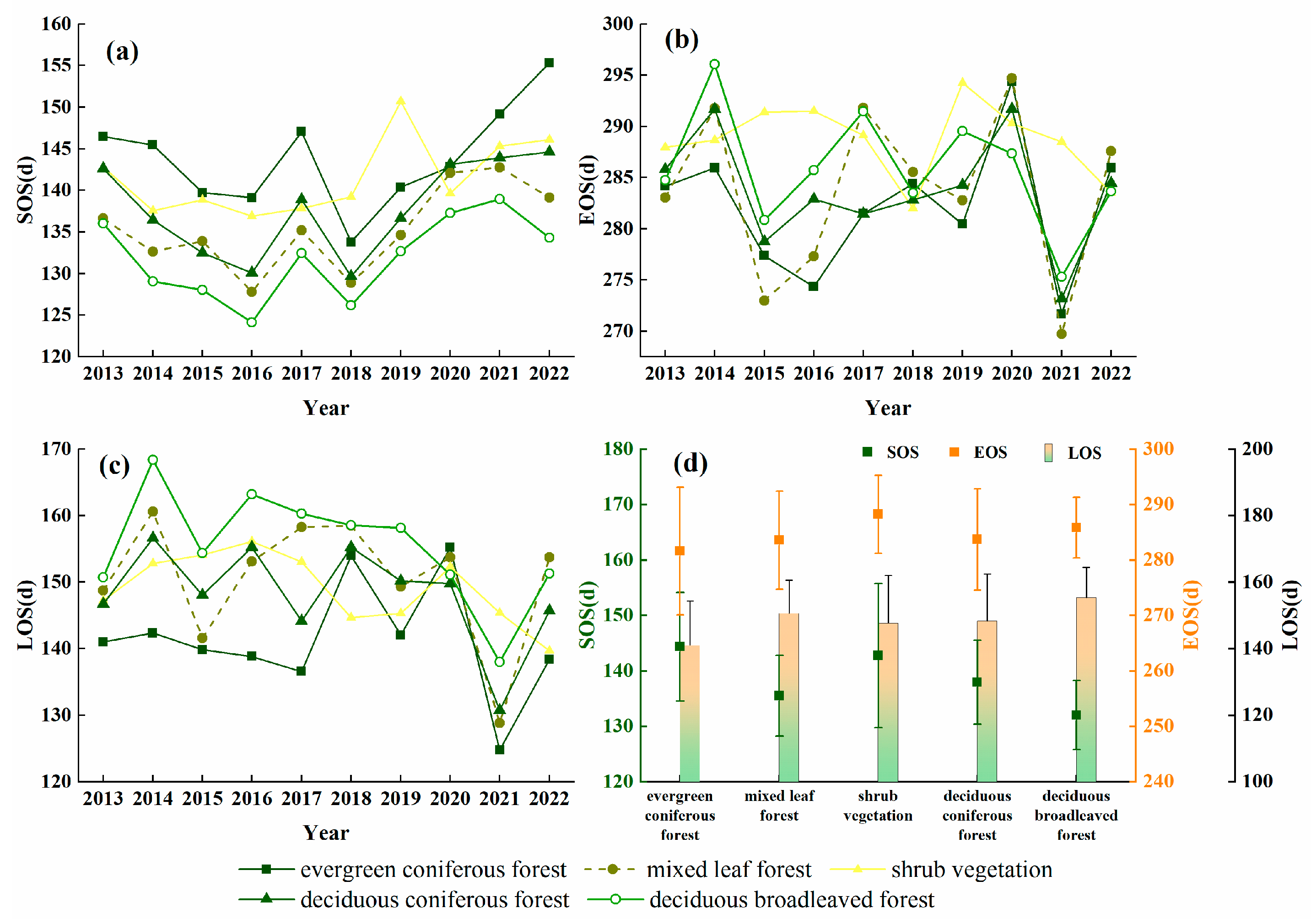
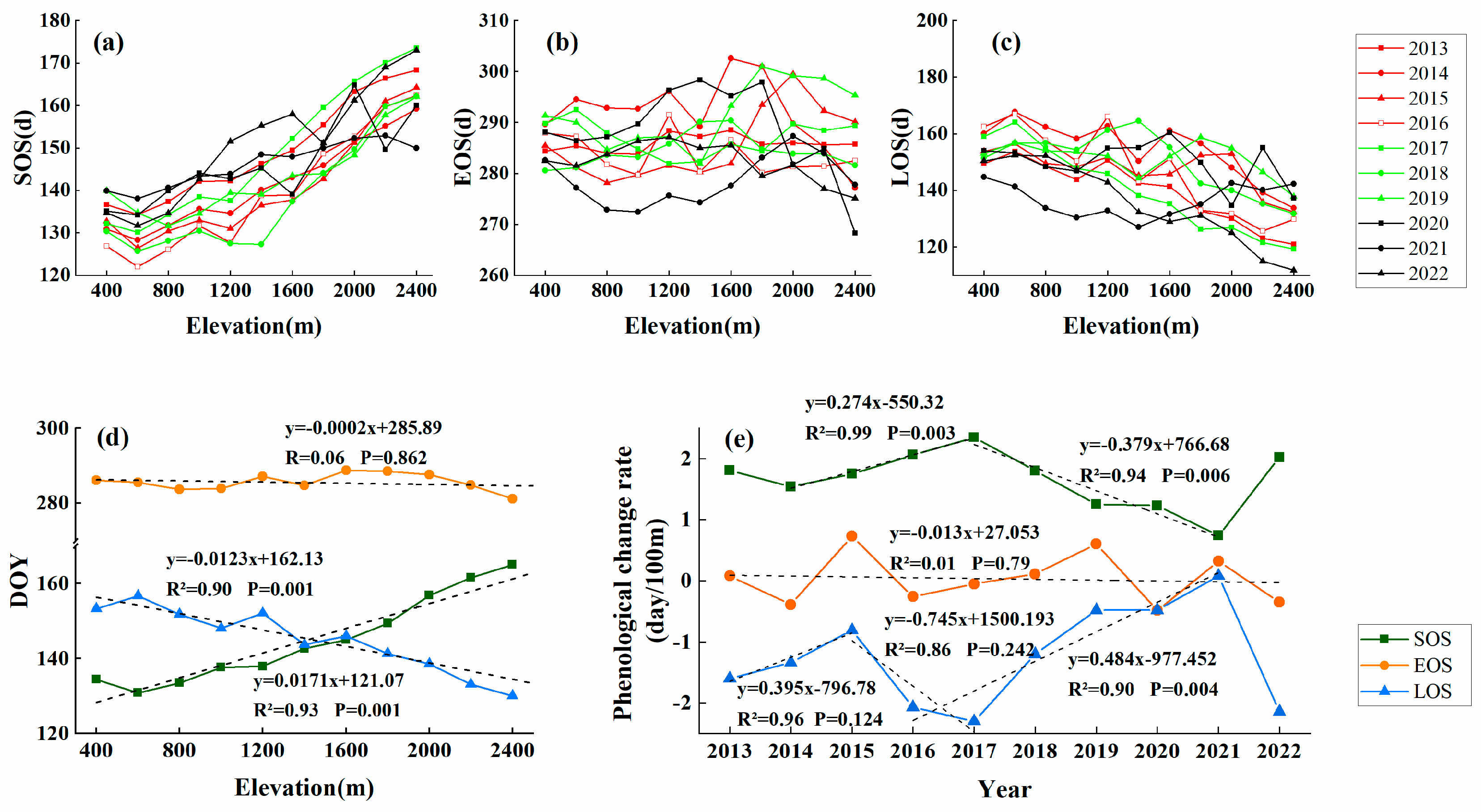


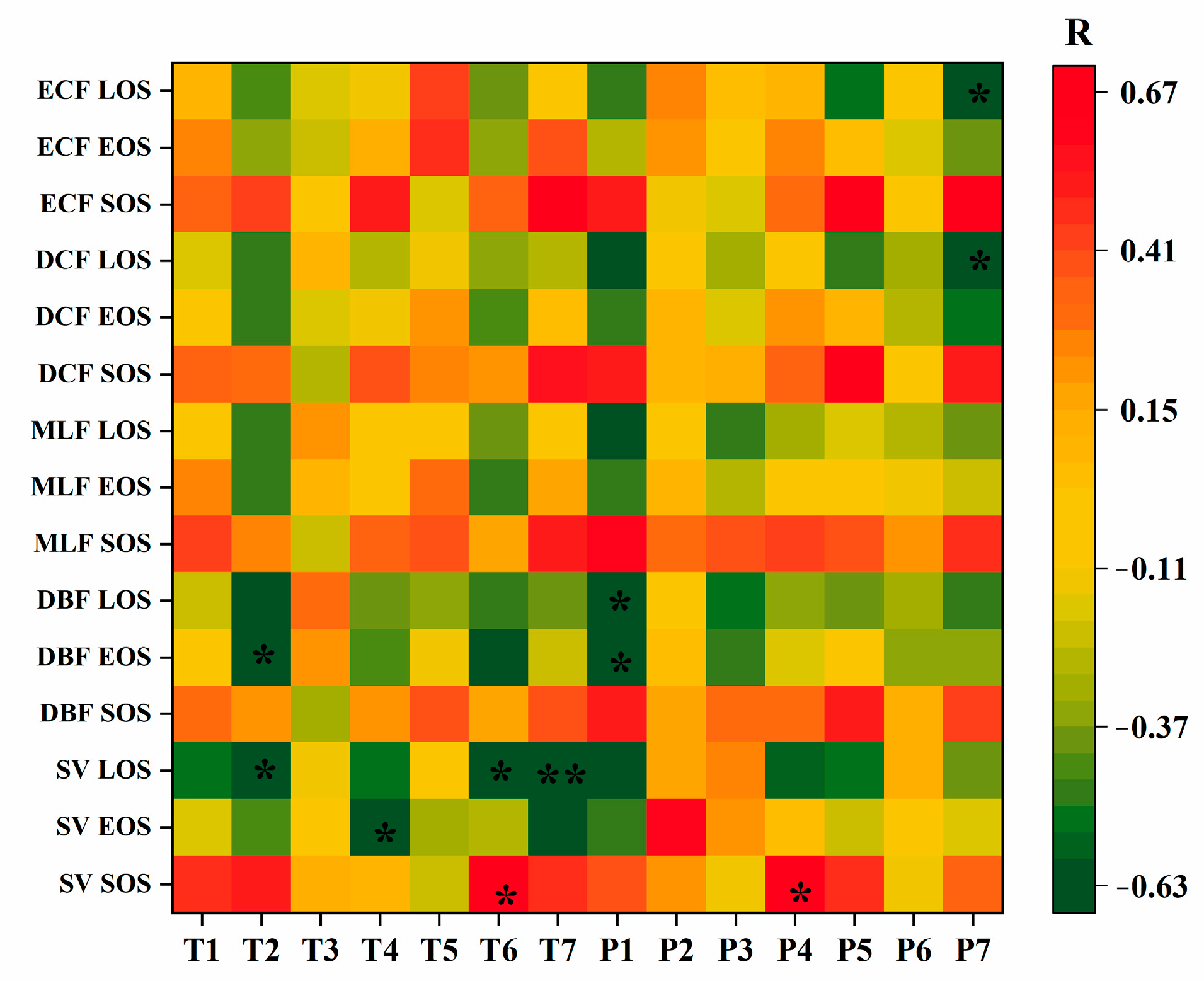
| Climate Factor | Abbreviation | Climate Factor | Abbreviation |
|---|---|---|---|
| Annual Temperature | T1 | Annual Precipitation | P1 |
| Spring Temperature | T2 | Spring Precipitation | P2 |
| Summer Temperature | T3 | Summer Precipitation | P3 |
| Autumn Temperature | T4 | Autumn Precipitation | P4 |
| Winter Temperature | T5 | Winter Precipitation | P5 |
| Pre-Autumn Temperature | T6 | Pre-Autumn Precipitation | P6 |
| Pre-Winter Temperature | T7 | Pre-Winter Precipitation | P7 |
| Forest Types | Pixel Number | Area (km2) | Proportion (%) |
|---|---|---|---|
| Deciduous broadleaved forest | 2,400,163 | 2160.1467 | 56.06 |
| Deciduous coniferous forest | 1,444,066 | 1299.6594 | 33.73 |
| Evergreen coniferous forest | 199,382 | 179.4438 | 4.66 |
| Shrub vegetation | 158,680 | 142.812 | 3.70 |
| Non-vegetation | 43,084 | 38.7756 | 1.01 |
| Mixed leaf forest | 36,318 | 32.6862 | 0.84 |
Disclaimer/Publisher’s Note: The statements, opinions and data contained in all publications are solely those of the individual author(s) and contributor(s) and not of MDPI and/or the editor(s). MDPI and/or the editor(s) disclaim responsibility for any injury to people or property resulting from any ideas, methods, instructions or products referred to in the content. |
© 2023 by the authors. Licensee MDPI, Basel, Switzerland. This article is an open access article distributed under the terms and conditions of the Creative Commons Attribution (CC BY) license (https://creativecommons.org/licenses/by/4.0/).
Share and Cite
Jiang, J.; Yu, Q.; Mickler, R.A.; Tang, Q.; Liang, T.; Zhang, H.; Song, K.; Wang, S. Forest Phenology under Differing Topographic Conditions: A Case Study of Changbai Mountain in Northeast China. Forests 2023, 14, 1466. https://doi.org/10.3390/f14071466
Jiang J, Yu Q, Mickler RA, Tang Q, Liang T, Zhang H, Song K, Wang S. Forest Phenology under Differing Topographic Conditions: A Case Study of Changbai Mountain in Northeast China. Forests. 2023; 14(7):1466. https://doi.org/10.3390/f14071466
Chicago/Turabian StyleJiang, Jie, Quanzhou Yu, Robert A. Mickler, Qingxin Tang, Tianquan Liang, Hongli Zhang, Kaishan Song, and Shaoqiang Wang. 2023. "Forest Phenology under Differing Topographic Conditions: A Case Study of Changbai Mountain in Northeast China" Forests 14, no. 7: 1466. https://doi.org/10.3390/f14071466
APA StyleJiang, J., Yu, Q., Mickler, R. A., Tang, Q., Liang, T., Zhang, H., Song, K., & Wang, S. (2023). Forest Phenology under Differing Topographic Conditions: A Case Study of Changbai Mountain in Northeast China. Forests, 14(7), 1466. https://doi.org/10.3390/f14071466






